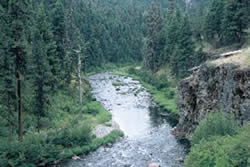
National Fire Plan Success Story
Pacific Northwest Research Since 2008
Managing Fish in Fire Prone Ecosystems
National Fire Plan - Rehabilitation
2008

Natural disturbances, including fire, can contribute to the maintenance of watershed processes, as long as stream and riparian connectivity are sustained and disturbances are not chronic.
Efforts to maintain, rebuild, or enhance fish populations in fire-adapted ecosystems are often riddled with confusion and controversy. Land managers must balance multiple goals, including ecological objectives, decreasing wildfire risk, and devising socially acceptable approaches to post-fire recovery.
Good science can help managers navigate this difficult decision space. Management actions are sometimes still based on the long-held view that aquatic ecosystems are static through time. This notion has contributed to the creation of policy that treats any disturbance, including fire, as unacceptable, further complicating the decision space faced by land managers.
The Fish & Fire initiative brings new science information into policy discussion and management decisions. It assimilates new information and innovative techniques, technologies, and protocols to create awareness among potential users and then to provide them with the assistance they need to manage using the latest science.
In 2008, the Focused Science Delivery Program of U.S. Forest Service Pacific Northwest Research held round table workshops where scientists and managers identified and discussed informational and managerial needs surrounding the management and enhancement of fisheries in fire prone ecosystems. After the meetings, an assessment was prepared of needed research that could improve policy and help managers as they grapple with the challenges of fish/fire interactions. One of the conclusions from this assessment was rather than view “fish” management and “fire” management as disparate objectives that must be somehow fused, the goal should be to restore and manage whole ecosystems by recognizing and capitalizing on their similarities and linkages.
Natural disturbances, including fire, can contribute to the maintenance of watershed processes, as long as stream and riparian connectivity are sustained and disturbances are not chronic. The Fish & Fire initiative proposes to explore further these linkages in one or more Demonstration Watersheds. These watersheds will provide opportunities to test new analytical techniques in the context of planning for management activities, and provide opportunities to enhance communication and information exchange among researchers, natural resource practitioners, and the public around these issues.
For more information, contact Jamie Barbour, PNW, Portland, OR, 503.808.2542, jbarbour01@fs.fed.us.